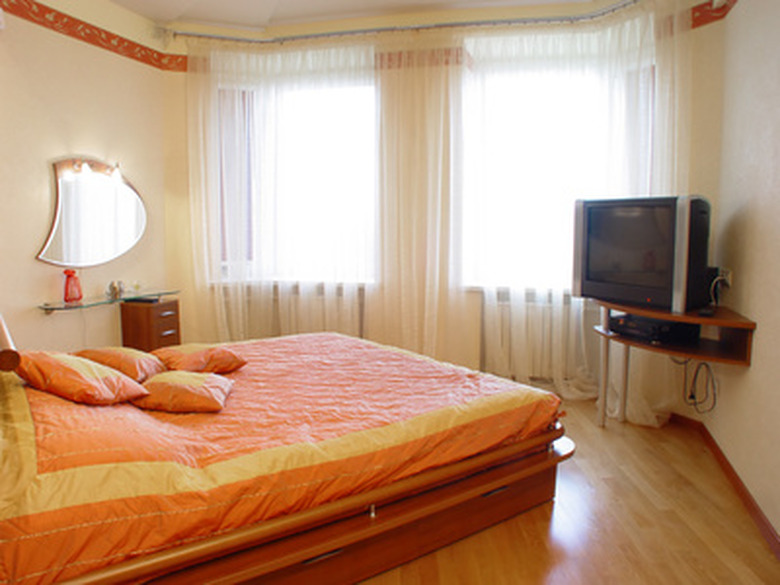How To Make A Carport Into A Master Suite
Things Needed
-
Tape measure
-
Graph paper and pencil
-
Architectural blueprints
-
Building permit
-
Level
-
Hammer
-
Circular or table saw
-
2-by-4s or 2-by-6s
-
Vapor barrier
-
Stapling gun and staples
-
Anchor bolts
-
Shims
-
3/4-inch plywood
-
3-inch nails
-
Exterior vapor shield
-
Windows
-
Exterior finish to match existing house
-
Flooring
-
Insulation
-
Drywall
-
Drywall screws
-
Drywall tape
-
Joint compound
-
Sandpaper
-
Screwdriver
-
Utility knife
-
Window and baseboard trim
-
Miter saw
-
Primer
-
Paint
-
Paintbrush
Converting an attached carport into a master suite is one of the most sensible ways to gain necessary square footage in a home without the expense and bother of a full-fledged addition. You'll need to check with your local building code authorities to see what modifications need to be done in terms of building out the room. Also, you'll need to provide room for another form of garage building and car storage.
Preparation
Step 1
Measure the room and transfer the dimensions to graph paper. Make note of existing window and door placements. Add in where you'd like new windows to go, keeping your furniture in mind. If there is an exterior door, decide if you want it to stay or be closed off. Look at where the door from the existing carport enters the home and decide if you want to keep it in its current location or if another entry would make better sense. Try to position the bathroom in a location where plumbing can tie into existing lines.
Step 2
Check with local building authorities on how thick the walls need to be for interior living space. Check to make certain that the existing roof trusses are within the specified guidelines. Floors in a garage or carport are frequently sloped towards the opening for drainage, and must by law be a step lower than the living space. Decide if you want to keep the step or make the floor level with the rest of the interior. The floor must be made level regardless of whether you wish to keep the step, and it's often easier to install plumbing and electrical lines under a raised floor. Add in heating/air conditioning ducts.
Step 3
Take your drawings to an architect to get blueprints made.
Rough in the Carport
Step 1
Build the exterior walls of the new room, using your blueprints to frame in the window openings. Use either 2-by-4s or 2-by-6s for studs, depending on how much insulation your area building authorities require. Place the studs every 16 inches, and anchor the walls to the flooring with anchor bolts. Insert windows where planned.
Step 2
Lay a vapor barrier over the existing floor of the carport, stapling it to the walls, about 6 inches up.
Step 3
Install sleeper studs on the floor, assuming you are raising the height. Use 2-by-4s or 2-by-6s, to match the floor to the height of the rest of the house, remembering that 3/4-inch plywood and a finished floor of some kind will sit on top of these studs. Assemble the floor and nail the pieces together. Anchor it to each wall over the vapor barrier. Use shims to get the studs level. Do not punch holes into the floor of the vapor barrier.
Step 4
Rough in the plumbing, HVAC and electrical work before closing the walls and flooring.
Step 5
Staple a vapor shield over the new walls on the outside of the house. Install exterior siding, brick or stone to match the rest of the home.
Finish the Room
Step 1
Lay down a 3/4-inch plywood subfloor over the sleeper studs, and nail in place, making certain that each end lines up over a stud.
Step 2
Build any interior partitions in the room, for closets and bathroom. Anchor these walls to the subfloor with anchor bolts.
Step 3
Finish the rough electrical and any remaining plumbing, then add insulation on all exterior walls. You may want to add insulation in the bathroom wall as well, for a sound barrier.
Step 4
Attach drywall to the studs, using drywall screws. Cut out any electrical boxes and around windows with a utility knife. Tape the drywall seams with joint compound. Allow the compound to dry, then sand it down and add another layer, smoothing the compound to close off the joint.
Step 5
Install the flooring of your choice. Add window and baseboard trim and prime and paint the room. Add switch plate covers.
Tip
To make the exterior look less like a garage conversion, tear up a portion of the driveway that used to lead into the carport and add some plants along the front of the house.
